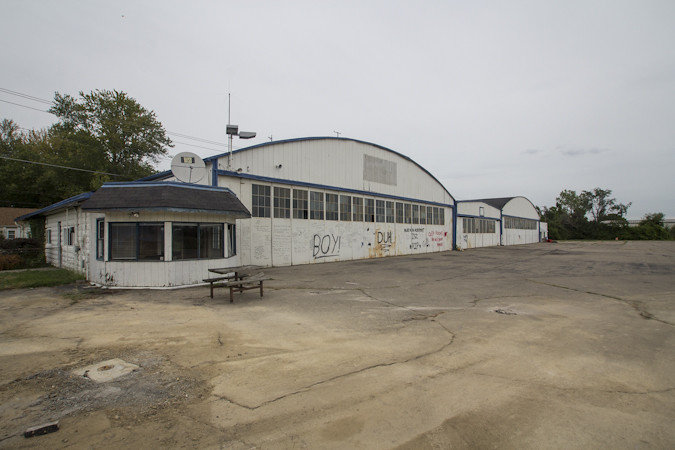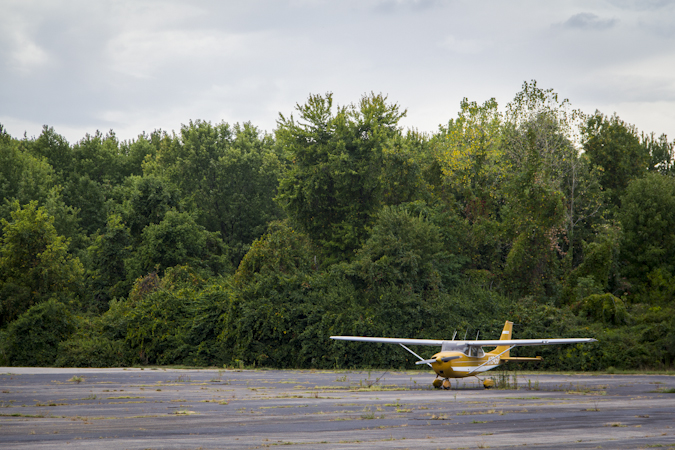The Blue Ash Airport

When it comes to abandoned suburbia, one might think about closed fast food joints, shuttered gas stations or foreclosed homes. In Blue Ash though, there stands a small, closed airport. A piece of aviation history is set to be demolished for a new community park in a growing suburb amidst a political controversy that raises questions about the modern day pursuit of truth.
 |
| - The first of the demolition equipment on the Blue Ash Airport scene. |
When I was a kid, all I ever wanted to be was a fighter pilot. I had a VHS tape of a documentary on The Blue Angels that I watched repeatedly and every summer my Dad took me to the Dayton Air Show. Despite all that, I had never actually flown in a plane. When I turned 14, my parent's surprised me by taking me to The Blue Ash Airport where Jerome, a coworker of my Dad, took me on my first flight in a small two-seater propeller plan above the suburban landscape.
Eventually my interests shifted from being an aviator to being a photographer, but I still have an admiration and love for flying. Sometimes, I get to combine the two and shoot photographs from planes. Blue Ash was where my good friend Gabriel kindly took me and my camera into the air multiple times.
 |
In its last days, The Blue Ash Airport (which had the callsign of ISZ) was a solitary runway in the middle of one of Cincinnati's most prolific suburbs, flanked by office parks and hotels. There was no control tower, no baggage claim, no Homeland Security; just a small and friendly regional airport that catered to recreational pilots and a few business flights. Plans for the airport had once been more ambitious and despite being located in the suburbs, it was actually owned by the city of Cincinnati.
ISZ was born in 1921 as Grisard Field by the Grisard Company. Just four years later, the Grisard Company eyed another potential airport location and sold off ISZ to Hugh and Parks Watson. Grisard went on to create Cincinnati's famous Lunken Airport while the Watson Brothers continued to operate Blue Ash. As commercial aviation continued to grow in demand and technology, Lunken was viewed as Cincinnati's choice location for an airport. Things changed in 1937 when the nearby Ohio River completely flooded over Lunken Airport.
 |
| - The closed tarmac of ISZ. |
After the flood waters receded, Cincinnati began to consider the Watson's Blue Ash Airport as the site for its major airport. Over the next several years, civic leaders went back and forth in deciding which location would become the region's main airline hub - Blue Ash or Lunken? The Watson Brothers sold their airport to Cincinnati in 1946, a year before Northern Kentucky was successful in receiving the first federal funds that would eventually lead to the birth of the Cincinnati/Northern Kentucky International Airport (CVG). When the jet age arrived, CVG had made itself the dominant and preferred location for commercial flights and Cincinnati abandoned the idea of expanding Blue Ash or Lunken into international airports. Lunken had no room to expand and by 1961, Blue Ash had incorporated itself as a city. The rapidly growing suburb had quickly surrounded Cincinnati's airport and would've been a serious obstacle towards any major expansion. Blue Ash had successfully countered any plans Cincinnati had for building a major passenger airport on this side of the river. ISZ remained a single runway and CVG across the river grew into an international hub.
 |
| - Abandoned hangars and offices at ISZ. |
As the years went by, Blue Ash grew at a rapid rate. Office parks began and continue to spring up around the airport's location. The City of Cincinnati continued to own ISZ and funds from the Federal Aviation Administration helped keep the airport running as it served mainly recreational pilots.
In 2006, the cities of Cincinnati and Blue Ash began negotiating a sale of the airport. Blue Ash wanted a park, Cincinnati wanted to sell the land for capital revenue. Blue Ash voters approved a .25% earnings tax increase to fund various community projects such as a new recreation center and a new park at what would eventually be the former location of the airport. The two cities came to an agreement - Cincinnati would sell Blue Ash a portion of the airport land for $38.5 Million on which Blue Ash planned to build the park that voters had increased taxes for.
 |
| - Former aircraft parking spaces. |
A year after the first airport deal was made, Cincinnati began studying the construction of a modern streetcar. In the streetcar's financing plan, Cincinnati determined it would use $11 Million of the nearly $40 Million Blue Ash airport deal to partially fund streetcar construction. A snag was hit when the Federal Aviation Administration pointed out a clause in the deal that stated Cincinnati had to spend its sale proceeds solely on airport improvements. The FAA then recommended that if Cincinnati wanted to use the proceeds elsewhere that they renegotiate the deal with the City of Blue Ash. The cities came together again and a new deal was brokered on August 10, 2012. This time, the funds were free'd up for Cincinnati to use at its will and Blue Ash was cleared to begin building its new park. ISZ prepared to close down for good.
 |
| - Rendering of the City of Blue Ash's new park. |
On the evening of August 31, 2012 I left work and drove over to the airport where I had gone on my first flight. Barriers had been erected to prevent vehicles from entering the airport, all the buildings and hangars had been abandoned and the airport sat quietly along with demolition equipment that had already arrived on site.

The airport's original hangar had been graffitied with messages of thanks and goodbye.


Some messages wished the airport to "rest in peace:"

Others recounted "life-saving" memories like the one below:

A few attacked and blamed Cincinnati's Streetcar Plan for the airport's demise:
The graffiti highlighted a problem, but the problem was not Cincinnati's Streetcar. In the Blue Ash Airport's final days it became the political backdrop for a different transportation project due to the manipulation of a special interest group and the failed reporting of local media.
The Coalition Opposed to Additional Spending and Taxes (COAST) had unsuccessfully tried to stop Cincinnati's Streetcar two times before. In 2009 and 2011 the "tea party" aligned group penned legislation aimed specifically at halting the streetcar project. Both times, Cincinnati voters turned down the group's self-authored ballot initiatives and allowed the streetcar project to move forward. Since Cincinnati had announced plans to use a portion of the airport sale revenue for the streetcar, The Blue Ash airport became COAST's next target. The group pleaded with Blue Ash City Council to halt the sale, repeatedly crying to the local media about how the sale was a vast conspiracy by both cities to solely fund the streetcar - despite the fact that the streetcar had come to fruition after the original airport sale and only a proceed of the sale would be used to fund it among other capital projects in Cincinnati. Unfortunately, the local media ate the "controversy" up. Talk radio played host to COAST and local news outlets featured quotes by COAST members while repeatedly failing to mention the details of the sale or a timeline of events. Blue Ash City Council saw through the political charade and went forward with the re-done sale agreement anyways, affording a win-win situation for both cities.
| - The Blue Ash Airport when it was known as Hugh Watson Field. Photo via CincinnatiViews.net |
As the airport is prepared to be destroyed for park space in the near future, its final days serve not only as a historical look into the aviation history of Greater Cincinnati, but as a lesson regarding political hyperbole and modern journalism. The above graffiti message highlights a misinformed opinion of the events that transpired. Even if the streetcar had never been thought of or planned, this sale would have happened. Since the streetcar was factored into Cincinnati's plans after the initial sale, the Blue Ash Airport deal became then became a target for a special interest group hell-bent on attacking on a project that got them repeated media exposure with little accountability. In Cincinnati, voters had twice spoken in support of the streetcar and in Blue Ash, voters raised taxes to build a new park for their community. The message scribbled above shows that COAST's political spin had been successful at hoodwinking some into believing this was all an elaborate plan to build a streetcar when in reality it was an opportunity for two cities to pursue improvement by replacing an airport that served little advantage to either party. In the wake of all this, the local media had failed so miserably at investigating the story that Blue Ash City council had to pen an editorial to the Cincinnati Enquirer explaining their actions. Jake Mecklenborg of the UrbanCincy.com blog was the only one to highlight the finer details and timeline of the sale, while larger news outlets rode the waves of fabricated controversy.
 |
| - The sole remaining plane at Blue Ash on August 31, 2012. |
As I stood on the abandoned airport tarmac that evening, trucks were already hauling off airport equipment in preparation of the demolition. For many, The Blue Ash Airport's closure was the capstone to great memories, memories that even I had shared. I'll never forget the first time I flew at Blue Ash - the way the sky looked, how nervous I was, the buzz of the propeller and the excitement I felt. But just as my passions changed from aviation to photography, so changed the story of ISZ. The airport's closure wasn't just about aviation, it highlighted a growing concern in modern journalism and the quest for political truth. May these photographs serve as a memory of the airport's history and these words serve as a lesson in misinformation and the modern quest for truth.
Updates | Oct. 21, 2017:
- The airport has now been completely demolished and replaced with a new, massive park that's nearing completion.
- The Cincinnati Streetcar opened in September, 2016.

